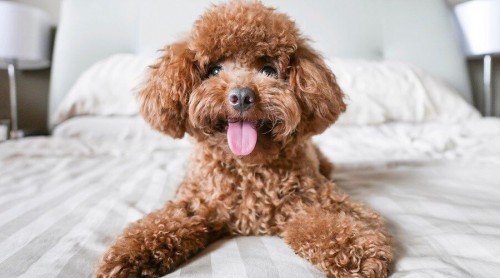
Toy poodles have a natural flair for the spotlight and there's no doubt why - their regal posture coupled with an impressive coat of curls always makes them stand out from the crowd. Their intelligence, athleticism, and undying devotion to owners big or small make these lovable pooches ideal as both companions for single people and beloved family pets.
Characteristics of the Toy Poodle
Toy poodles are charismatic family pets that love to be the center of attention. They are highly intelligent and take well to obedience training, but can suffer from separation anxiety due to their companionable nature. They do well around children and other pets and are well-suited to life in smaller spaces thanks to their petite size.
History of the Toy Poodle
Poodles were valued as far back as 400 years ago for their athleticism, intelligence and eagerness to please - all qualities that made them the perfect duck hunting dog in Germany. This dedication was rewarded with a unique warm coat, but savvy hunters soon discovered an even better way to ensure free range of movement while still protecting against icy temperatures: they simply shaved the poodle's legs, neck and tail! As such this canine icon evolved into its recognizable state today; tufts around chest joints left unshorn have become quite iconic (and irresistible!) when it comes Poodle fashion.
Poodles were valued as far back as 400 years ago for their athleticism, intelligence and eagerness to please - all qualities that made them the perfect duck hunting dog in Germany. This dedication was rewarded with a unique warm coat, but savvy hunters soon discovered an even better way to ensure free range of movement while still protecting against icy temperatures: they simply shaved the poodle's legs, neck and tail! As such this canine icon evolved into its recognizable state today; tufts around chest joints left unshorn have become quite iconic (and irresistible!) when it comes Poodle fashion.
Toy Poodle Care
Poodles might have a reputation for being the prima donnas of pooches, but they can actually make wonderful family companions with minimal upkeep. Especially when it comes to toy poodles - these pint-sized cuties require just minutes of grooming and exercise time each day.
Exercise
While larger standard poodles need plenty of room and exercise to thrive, smaller toy poodles do not. However, they are still an active breed and love going for daily walks with their loved ones. They also love swimming, retrieving, and performing tricks to burn off energy.
Grooming
Due to the toy poodle’s thick and curly coat, owners will need to brush their dogs daily from root to end to prevent any matting. If their coat develops mats, toy poodles may need to be shaved quite short to give their hair a chance to grow back nicely. Fine-toothed combs with sturdy teeth are great options to keep in your toy poodle grooming kit—they get the job done well without causing a significant amount of discomfort for the dog.
Toy poodles are the perfect furry friend for those with allergies, and also a joy to groom! Owner's can either opt to undertake trimming their pet's coat by themselves or go professional every six weeks. That way they will get not only an expert cut but also enjoy trouble-free play sessions without matting - plus a refreshing bath and nail clip too. With just some basic training your toy poodle should be content in no time at all when visiting their favourite grooming parlour.
Training
Toy poodles are an intelligent breed and absolutely love to please their owner. As active and graceful dogs, they excel at sporting activities. This may come as a shock to those who believe poodles are prissy or feminine—a common misconception. Toy poodles are great at learning and performing tricks.
Diet and Nutrition
The best food for your dog will depend on its size and activity level. Because toy poodles are small in size, they don’t require a large number of calories each day. If they are fed above their ideal caloric level, they may become overweight or even obese without proper exercise to burn it off. It’s important to work with your vet to find the right food for your pet and the portion control required to keep them healthy.
Whether you choose wet, raw, or dry food, you should go for something relatively high in protein and fiber, but without too many fillers like corn bran or oat hulls. The ideal dog food should contain mostly whole foods and quality sources of protein, including things like real meat and vegetables.








